Influence of Obesity and Unemployment on Fertility Rates: A Multinational Analysis of 30 Countries from 1976 to 2014
Abstract
:1. Introduction
2. Materials and Methods
2.1. Data
- (i)
- Western European OECD Countries (taken from the ones listed in [8]): Austria, Belgium, Denmark, Finland, France, Germany, Greece, Ireland, Italy, Luxemburg, Netherlands, Norway, Portugal, Spain, Sweden, Switzerland, UK.
- (ii)
- Eastern European OECD Countries: Czech Republic, Estonia, Hungary, Latvia, Poland, Slovak Republic, Slovenia.
- (iii)
- Excluded (neither of the above groups or no data available on obesity): Australia, Canada, Chile, Iceland, Israel, Japan, Korea, Lithuania, Mexico, New Zealand, Turkey, United States.
2.2. Statistical Analysis
3. Results
3.1. Descriptive Analysis
3.2. Mixed Effects Regression Models
3.2.1. Western OECD Countries
3.2.2. Eastern OECD Countries
3.2.3. Model including All Countries
4. Discussion
5. Conclusions
Supplementary Materials
Author Contributions
Funding
Informed Consent Statement
Data Availability Statement
Conflicts of Interest
References
- Currie, J.; Schwandt, H. Short-and long-term effects of unemployment on fertility. Proc. Natl. Acad. Sci. USA 2014, 111, 14734–14739. [Google Scholar] [CrossRef] [PubMed] [Green Version]
- Adsera, A.; Menendez, A. Fertility changes in Latin America in periods of economic uncertainty. Popul. Stud. 2011, 65, 37–56. [Google Scholar] [CrossRef] [PubMed]
- Tejada, C.A.O.; Triaca, L.M.; Da Costa, F.K.; Hellwig, F. The sociodemographic, behavioral, reproductive, and health factors associated with fertility in Brazil. PLoS ONE 2017, 12, e0171888. [Google Scholar] [CrossRef] [PubMed]
- Ermisch, J.F. Time costs, aspirations and the effect of economic growth on German fertility. Oxf. Bull. Econ. Stat. 1980, 42, 125–143. [Google Scholar] [CrossRef]
- Lee, R. The demographic response to economic crisis in historical and contemporary populations. Popul. Bull. U. N. 1990, 1990, 1–15. [Google Scholar]
- WHO. Available online: https://gateway.euro.who.int/en/indicators/hfa_25-0080-total-fertility-rate/ (accessed on 19 July 2020).
- Ball, P. Carl Djerassi (1923–2015). Nature 2015, 519, 34. [Google Scholar] [CrossRef] [Green Version]
- Karaman, Ö.D.D.; Goldstein, J.R. The changing relationship between unemployment and total fertility. Popul. Stud. 2018, 72, 109–121. [Google Scholar] [CrossRef]
- Sobotka, T.; Skirbekk, V.; Philipov, D. Economic recession and fertility in the developed world. Popul. Dev. Rev. 2011, 37, 267–306. [Google Scholar] [CrossRef]
- Puig-Barrachina, V.; Rodríguez-Sanz, M.; Domínguez-Berjón, M.F.; Martín, U.; Luque, M.Á.; Ruiz, M.; Perez, G. Decline in fertility induced by economic recession in Spain. Gac. Sanit. 2020, 34, 238–244. [Google Scholar] [CrossRef]
- Meisenberg, G. Wealth, intelligence, politics and global fertility differentials. J. Biosoc. Sci. 2009, 41, 519–535. [Google Scholar] [CrossRef]
- Götmark, F.; Andersson, M. Human fertility in relation to education, economy, religion, contraception, and family planning programs. BMC Public Health 2020, 20, 1–17. [Google Scholar] [CrossRef] [PubMed] [Green Version]
- Wolfe, J.D.; Baker, E.H.; Scarinci, I.C. Wealth and obesity among US adults entering midlife. Obesity 2019, 27, 2067–2075. [Google Scholar] [CrossRef] [PubMed] [Green Version]
- Vahratian, A. Prevalence of overweight and obesity among women of childbearing age: Results from the 2002 National Survey of Family Growth. Matern. Child Health J. 2009, 13, 268–273. [Google Scholar] [CrossRef] [PubMed] [Green Version]
- WHO. Obesity and Overweight. Available online: https://www.who.int/en/news-room/fact-sheets/detail/obesity-and-overweight (accessed on 19 July 2020).
- Ramlau-Hansen, C.; Thulstrup, A.; Nohr, E.; Bonde, J.; Sørensen, T.; Olsen, J. Subfecundity in overweight and obese couples. Hum. Reprod. 2007, 22, 1634–1637. [Google Scholar] [CrossRef] [PubMed] [Green Version]
- Best, D.; Bhattacharya, S. Obesity and fertility. Horm. Mol. Biol. Clin. Investig. 2015, 24, 5–10. [Google Scholar] [CrossRef] [PubMed]
- Broughton, D.E.; Moley, K.H. Obesity and female infertility: Potential mediators of obesity’s impact. Fertil. Steril. 2017, 107, 840–847. [Google Scholar] [CrossRef] [PubMed] [Green Version]
- van der Steeg, J.W. Obesity affects spontaneous pregnancy chances in subfertile, ovulatory women. Hum. Reprod. 2008, 23, 324–328. [Google Scholar] [CrossRef] [Green Version]
- Available online: https://unstats.un.org/unsd/methodology/m49/#geo-regions (accessed on 16 February 2022).
- Levels, M.; Sluiter, R.; Need, A. A review of abortion laws in Western-European countries. A cross-national comparison of legal developments between 1960 and 2010. Health Policy 2014, 118, 95–104. [Google Scholar] [CrossRef]
- Lim, A.Y.; Lee, S.-H.; Jeon, Y.; Yoo, R.; Jung, H.-Y. Job-Seeking Stress, Mental Health Problems, and the Role of Perceived Social Support in University Graduates in Korea. J. Korean Med. Sci. 2018, 33, e149. [Google Scholar] [CrossRef]
- Henriksen, T.B. General psychosocial and work-related stress and reduced fertility. Scand. J. Work. Environ. Health 1999, 25, 38–39. [Google Scholar]
- Joseph, D.N.; Whirledge, S. Stress and the HPA Axis: Balancing Homeostasis and Fertility. Int. J. Mol. Sci. 2017, 18, 2224. [Google Scholar] [CrossRef] [PubMed]
- Raisanen, J.C.; Chadwick, S.B.; Michalak, N.; Van Anders, S.M. Average Associations Between Sexual Desire, Testosterone, and Stress in Women and Men Over Time. Arch. Sex. Behav. 2018, 47, 1613–1631. [Google Scholar] [CrossRef] [PubMed]
- Latini, D.M.; Penson, D.; Wallace, K.L.; Lubeck, D.P.; Lue, T.F. Original research—Erectile Dysfunction: Clinical and Psychosocial Characteristics of Men with Erectile Dysfunction: Baseline Data from ExCEED. J. Sex. Med. 2006, 3, 1059–1067. [Google Scholar] [CrossRef] [PubMed]
- Costa-Tutusaus, L.; Guerra-Balic, M. Relationship between Healthy Lifestyle and Sociodemographic Factors in Adolescents in Catalonia: Application of VISA-TEEN Questionnaire. PLoS ONE 2016, 11, e0163381. [Google Scholar]
- Head, J.; Chungkham, H.S.; Hyde, M.; Zaninotto, P.; Alexanderson, K.; Stenholm, S.; Salo, P.; Kivimaki, M.; Goldberg, M.; Zins, M.; et al. Socioeconomic differences in healthy and disease-free life expectancy between ages 50 and 75: A multi-cohort study. Eur. J. Public Health 2019, 29, 267–272. [Google Scholar] [CrossRef]
- Węziak-Białowolska, D. Health conditions in regions of Eastern and Western Europe. Int. J. Public Health 2014, 59, 529–539. [Google Scholar] [CrossRef]
- Becker, C.M.; Hemley, D.D. Demographic change in the former Soviet Union during the transition period. World Dev. 1998, 26, 1957–1975. [Google Scholar] [CrossRef]
- Deuchert, E.; Cabus, S.; Tafreschi, D. A short note on economic development and socioeconomic inequality in female body weight. Health Econ. 2014, 23, 861–869. [Google Scholar] [CrossRef] [Green Version]
- Templin, T.; Hashiguchi, T.C.O.; Thomson, B.; Dieleman, J.; Bendavid, E. The overweight and obesity transition from the wealthy to the poor in low- and middle-income countries: A survey of household data from 103 countries. PLoS Med. 2019, 16, e1002968. [Google Scholar] [CrossRef] [Green Version]
- Raymo, J.M.; Shibata, A. Unemployment, nonstandard employment, and fertility: Insights from Japan’s “Lost 20 Years”. Demography 2017, 54, 2301–2329. [Google Scholar] [CrossRef]
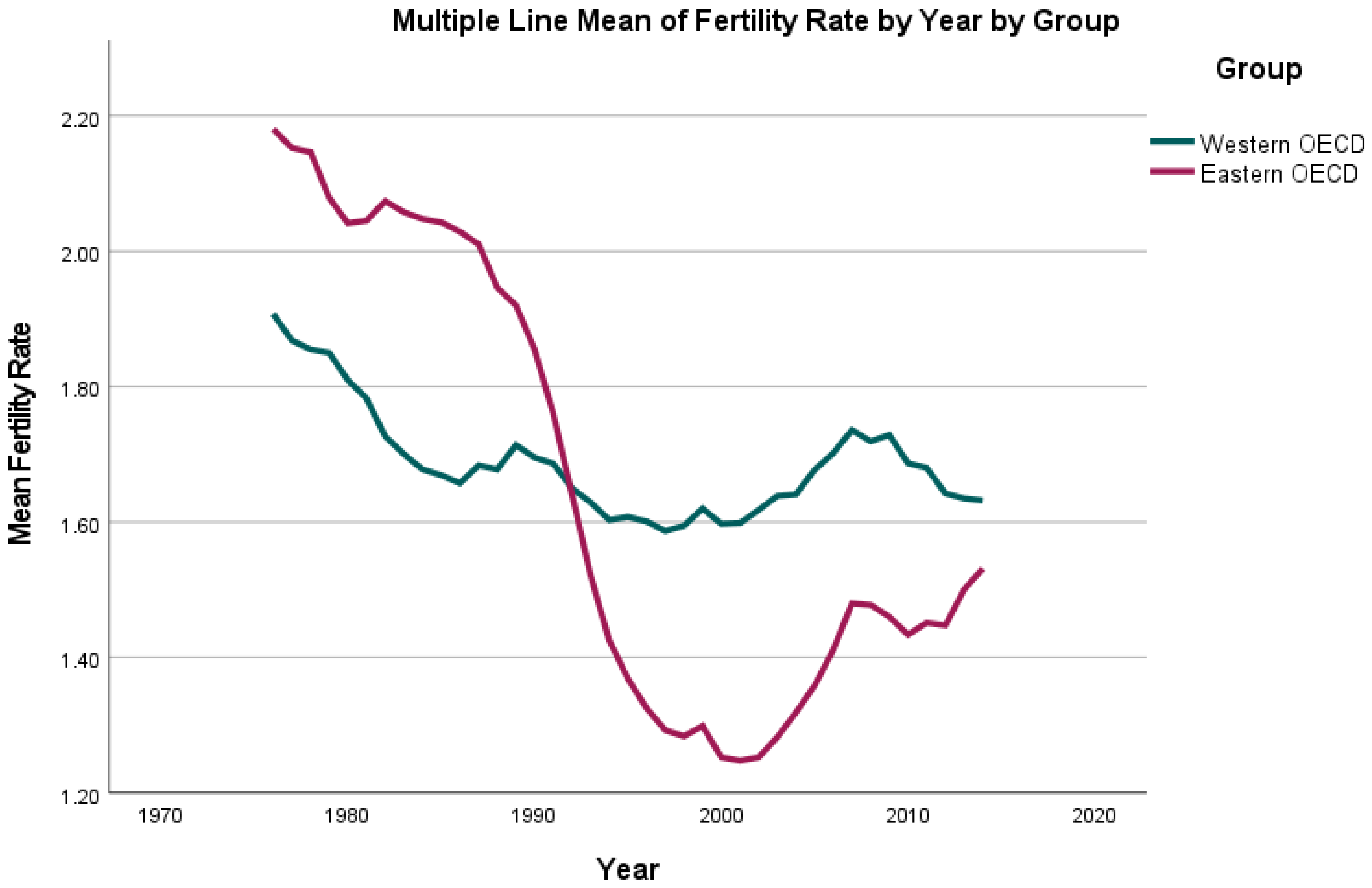
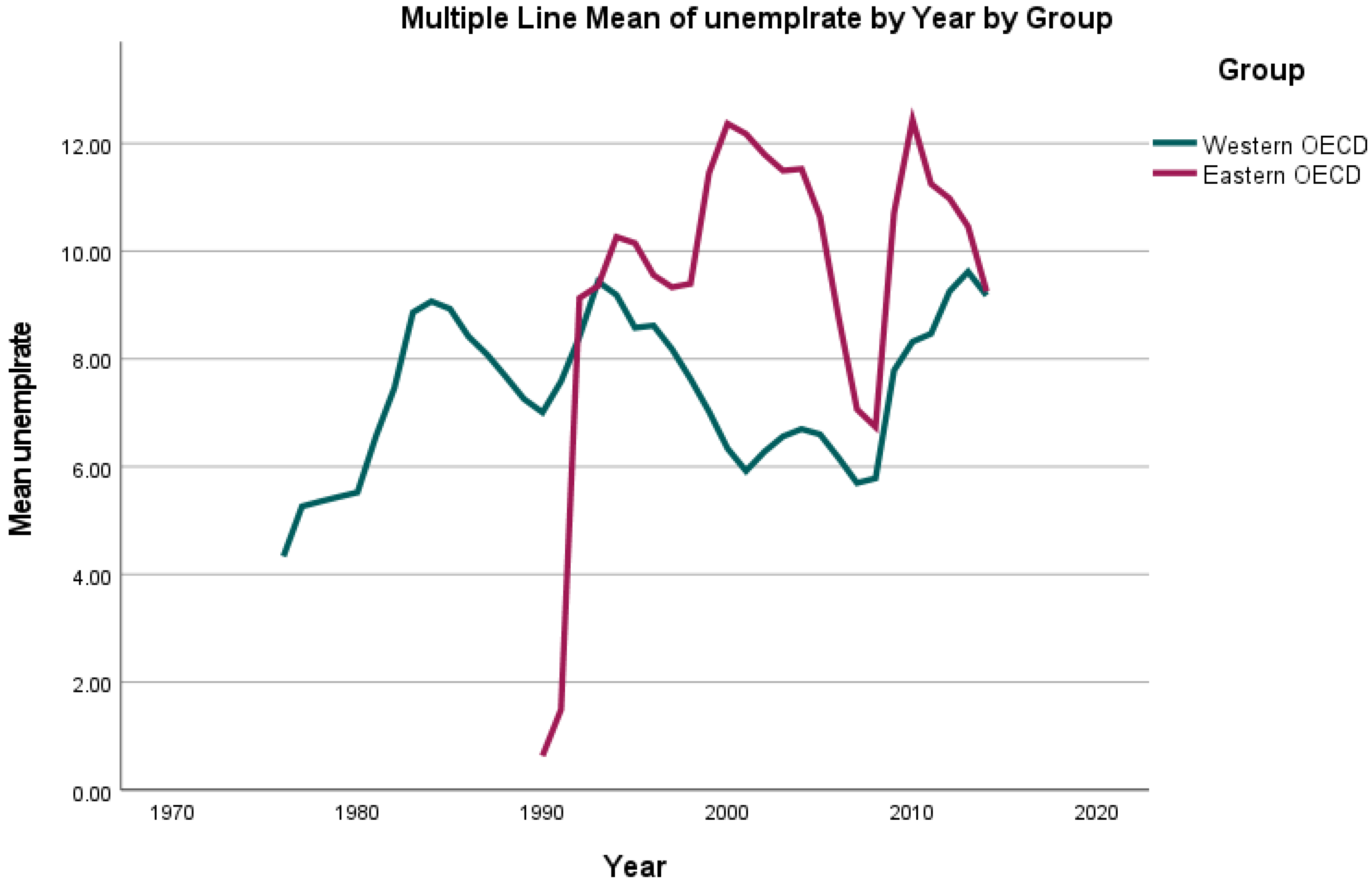
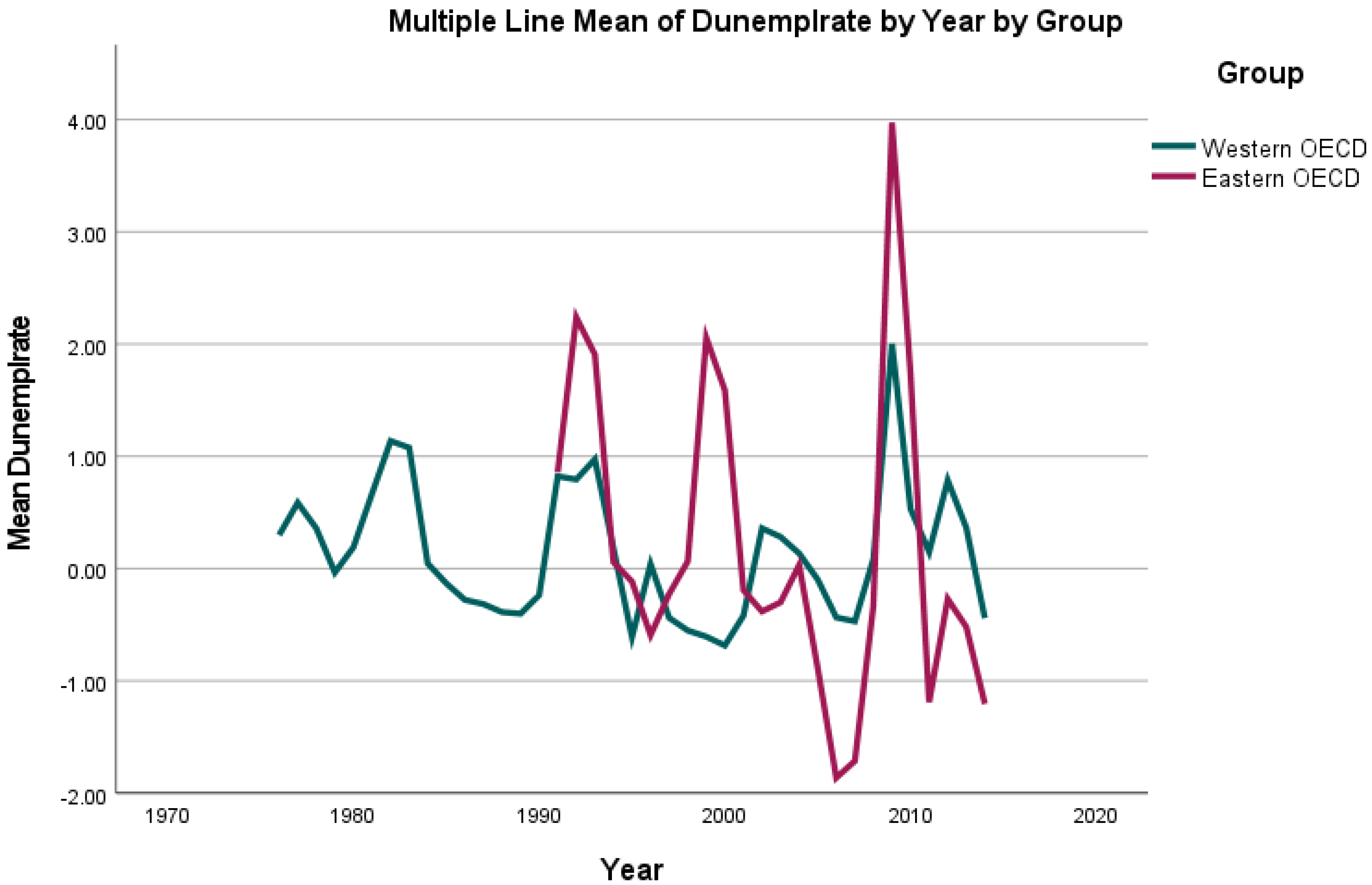
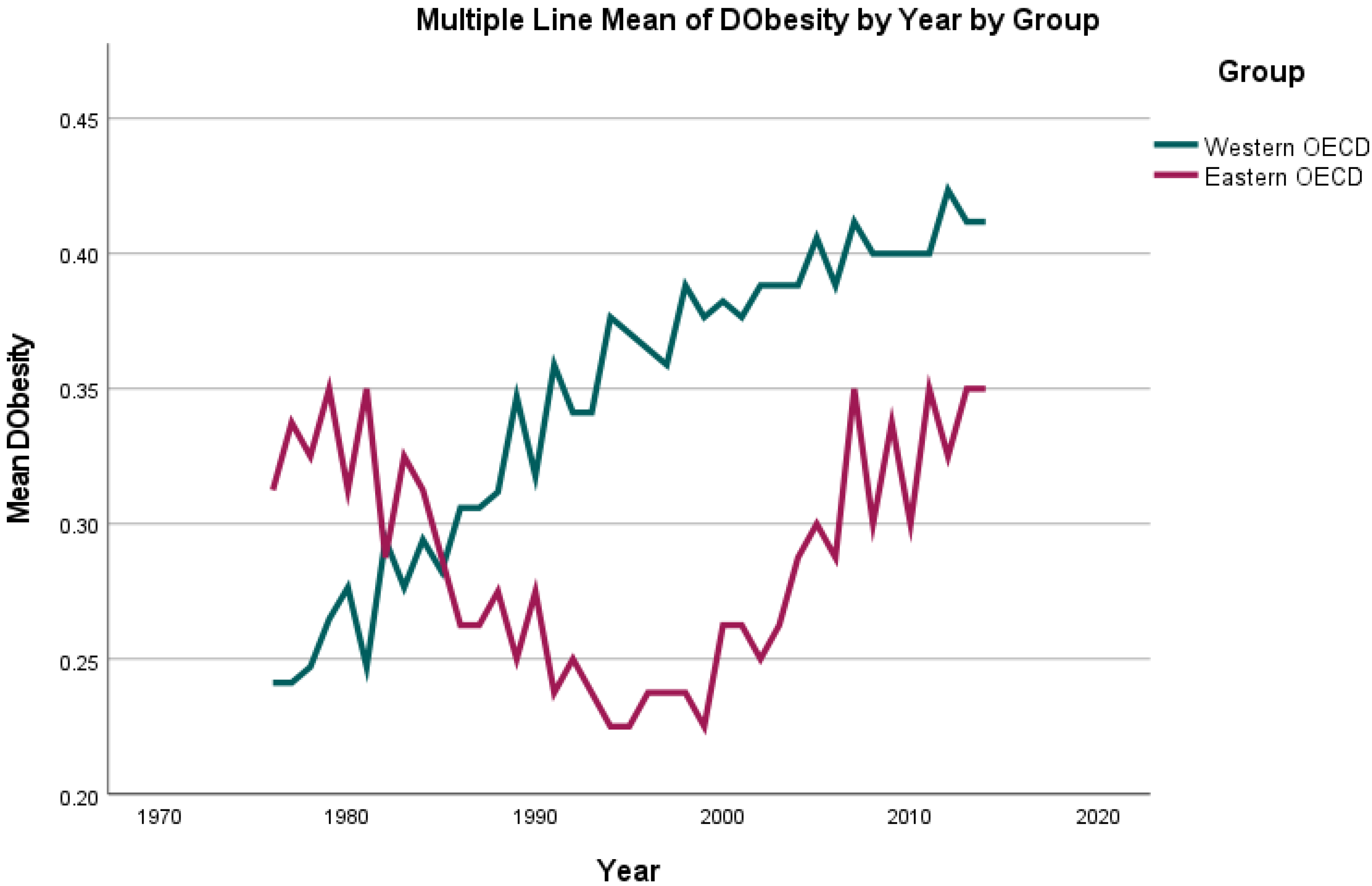
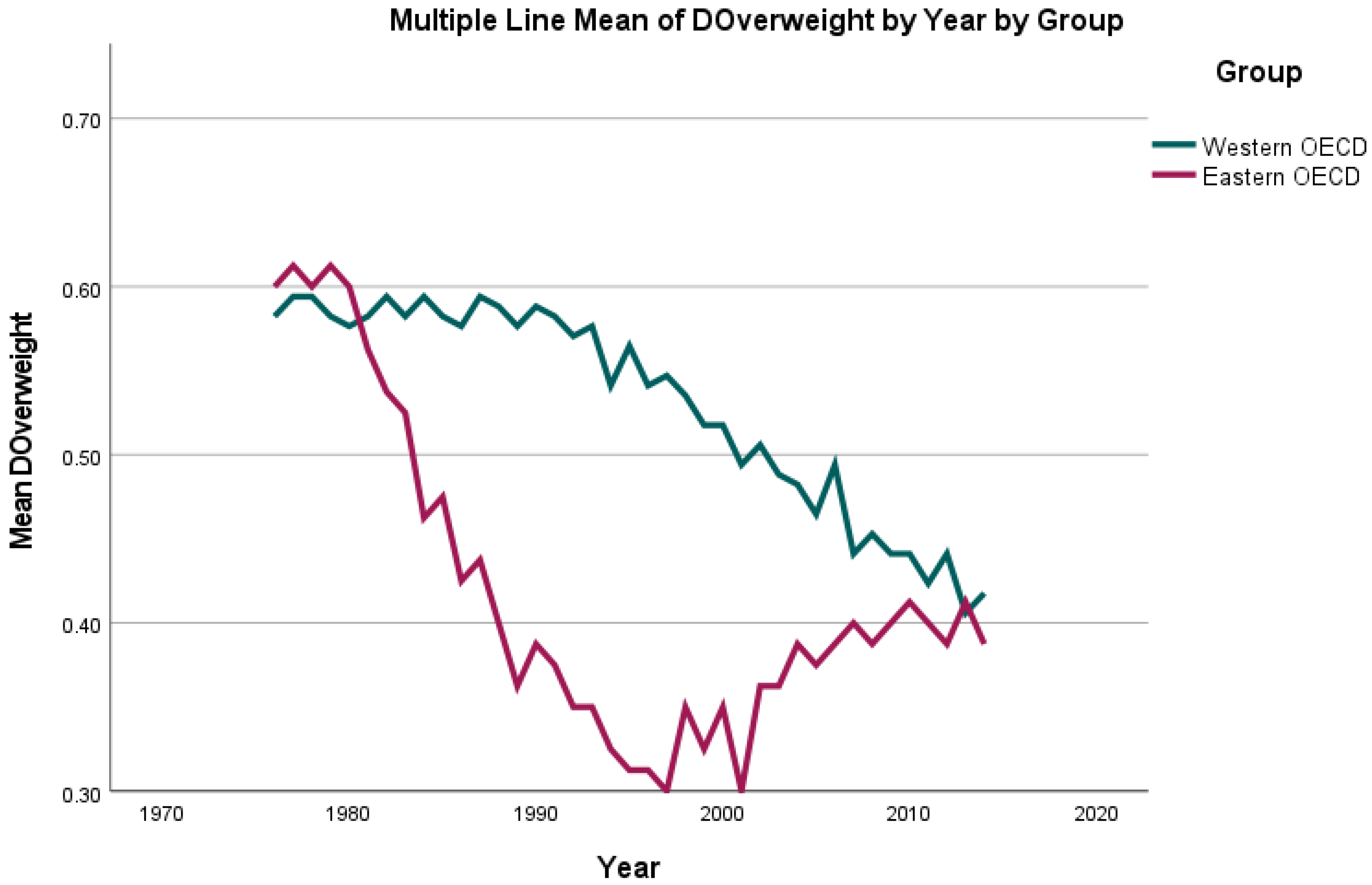
| Variables | Western European Countries | Eastern European Countries | All included Countries |
|---|---|---|---|
| dUnemplrate | −0.0026 *** | −0.0034 *** | −0.0028 *** |
| dOverweight | −0.0088 ** | 0.0242 | 0.0006 |
| Year | 0.00015 | 0.00087 * | 0.00040 ** |
Publisher’s Note: MDPI stays neutral with regard to jurisdictional claims in published maps and institutional affiliations. |
© 2022 by the authors. Licensee MDPI, Basel, Switzerland. This article is an open access article distributed under the terms and conditions of the Creative Commons Attribution (CC BY) license (https://creativecommons.org/licenses/by/4.0/).
Share and Cite
König-Castillo, D.M.; Ott, J.; König, D.; Hager, M.; Kahr, M.K.; Dorffner, G. Influence of Obesity and Unemployment on Fertility Rates: A Multinational Analysis of 30 Countries from 1976 to 2014. J. Clin. Med. 2022, 11, 1152. https://doi.org/10.3390/jcm11051152
König-Castillo DM, Ott J, König D, Hager M, Kahr MK, Dorffner G. Influence of Obesity and Unemployment on Fertility Rates: A Multinational Analysis of 30 Countries from 1976 to 2014. Journal of Clinical Medicine. 2022; 11(5):1152. https://doi.org/10.3390/jcm11051152
Chicago/Turabian StyleKönig-Castillo, Deirdre Maria, Johannes Ott, Daniel König, Marlene Hager, Maike Katja Kahr, and Georg Dorffner. 2022. "Influence of Obesity and Unemployment on Fertility Rates: A Multinational Analysis of 30 Countries from 1976 to 2014" Journal of Clinical Medicine 11, no. 5: 1152. https://doi.org/10.3390/jcm11051152
APA StyleKönig-Castillo, D. M., Ott, J., König, D., Hager, M., Kahr, M. K., & Dorffner, G. (2022). Influence of Obesity and Unemployment on Fertility Rates: A Multinational Analysis of 30 Countries from 1976 to 2014. Journal of Clinical Medicine, 11(5), 1152. https://doi.org/10.3390/jcm11051152







